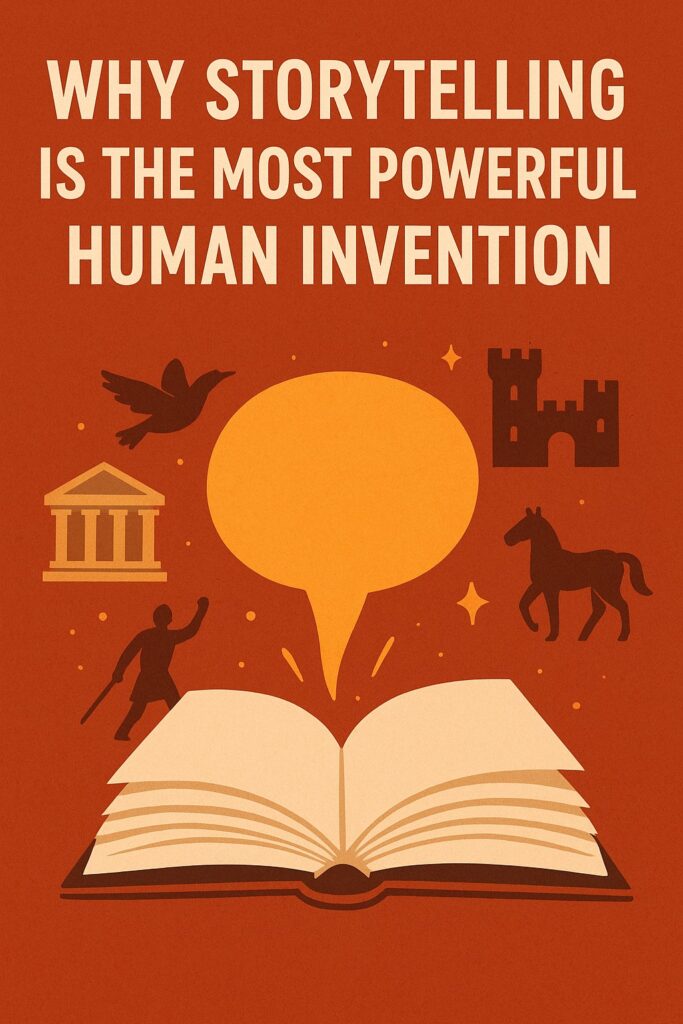By Swayam Nerkar
In the vast history of human civilization, one invention has shaped societies, preserved knowledge, and influenced emotions more than any tool, weapon, or machine. That invention is storytelling. From ancient cave paintings to modern-day films, stories have been the most powerful force driving human culture, communication, and imagination. Unlike physical inventions such as the wheel, electricity, or the internet, storytelling is an intellectual and emotional creation that transcends time, geography, and technology.
This article explores why storytelling is the most powerful human invention, how it has evolved, and why it continues to shape our personal lives, businesses, education, and even politics.
The Origins of Storytelling
The roots of storytelling trace back tens of thousands of years. Long before writing systems or digital media, early humans painted scenes of hunts and rituals on cave walls. These cave paintings were the earliest stories, visual narratives meant to teach, inspire, or warn future generations.
Storytelling emerged as a survival tool. By sharing experiences through tales, humans could transfer knowledge without firsthand experience. For instance, a story about a poisonous plant or a dangerous animal could save lives without each person having to encounter that danger.
Thus, storytelling was humanity’s first information system, a way of encoding lessons, values, and wisdom.
Storytelling as the Foundation of Culture
No culture can exist without stories. Every civilization, from Mesopotamia to Egypt, India to Greece, passed down myths, legends, and oral traditions. These narratives gave people a shared sense of identity and belonging.
- Religions are built on stories: Ancient scriptures, parables, and mythologies are all structured as narratives.
- Societies are shaped by folklore: Heroes, gods, and moral tales reinforced values and provided role models.
- Nations are united by history: Every country tells a version of its past through stories that bind citizens together.
In this way, storytelling became the glue of human culture, stronger than any law or government decree.
The Psychology of Storytelling: Why Our Brains Love Stories
Modern neuroscience proves what humans have intuitively known for centuries: the human brain is wired for stories. Unlike raw facts or statistics, stories engage multiple parts of the brain, making information easier to understand and remember.
- Dopamine and memory: When we hear a compelling story, our brains release dopamine, enhancing focus and recall.
- Empathy and mirror neurons: Stories trigger mirror neurons, allowing us to experience others’ emotions.
- Attention and engagement: Stories hold our attention far better than bullet points or data.
This explains why people forget lectures but remember parables, why advertising jingles stick, and why movies can make us laugh or cry. Storytelling is not just communication—it’s an emotional experience.
Storytelling as Education
One of the greatest roles of storytelling has been teaching and learning. Before schools existed, stories were the primary form of education. Even today, teachers and educators use stories to simplify complex concepts.
- Fables and moral lessons: Ancient tales like Aesop’s fables distilled deep moral truths into simple narratives.
- Myths and science: Before scientific explanation, stories helped people understand natural phenomena like thunder, eclipses, or the seasons.
- Modern classrooms: Teachers today use stories, metaphors, and case studies to connect with students.
Research shows that students retain knowledge better when it is delivered in story form rather than as dry facts. This is why stories remain essential in both childhood learning and higher education.
Storytelling in Business and Marketing
In today’s digital economy, storytelling is the engine behind powerful brands. Consumers no longer buy products; they buy stories.
- Brand identity: Companies like Apple, Nike, and Tesla thrive not just because of their products but because of the stories they tell about innovation, ambition, and lifestyle.
- Advertising: The most memorable ads tell a story rather than just list features.
- Content marketing: Blogs, videos, and podcasts succeed when they frame information as a narrative that entertains or inspires.
For businesses, storytelling is a competitive advantage. A product without a story is easily forgotten, but a story-driven brand becomes part of people’s lives.
Storytelling and Technology
While some may argue that inventions like the printing press, electricity, or the internet are more important, all these technologies are ultimately tools for storytelling.
- The printing press enabled mass distribution of stories through books and newspapers.
- Film and television brought stories to life through moving images.
- The internet and social media democratized storytelling, allowing anyone to share their narrative with the world.
Even emerging technologies like virtual reality, artificial intelligence, and gaming are simply advanced platforms for immersive storytelling. This proves that while tools evolve, the core invention—storytelling—remains timeless.
Storytelling in Politics and Leadership
Leaders throughout history have used stories to inspire, persuade, and control. A powerful story can unite nations, ignite revolutions, or even manipulate societies.
- Political campaigns rely on narratives of hope, change, or patriotism.
- Social movements thrive on powerful stories of injustice and resilience.
- Speeches that shaped history—from Martin Luther King Jr.’s “I Have a Dream” to Gandhi’s calls for freedom—are all crafted as stories.
This shows that storytelling is the foundation of leadership and influence. Facts may convince, but only stories move people to action.
Storytelling in the Digital Age
The 21st century has made storytelling more powerful than ever. Platforms like YouTube, TikTok, Instagram, and podcasts prove that people crave stories in every form—visual, audio, and text.
- Social media influencers build empires by telling authentic stories.
- Memes and viral content are micro-stories that spread globally within seconds.
- User-generated content shows how everyone is now both a consumer and creator of stories.
In the digital era, storytelling is no longer the privilege of writers, filmmakers, or leaders. Every individual can tell their story and impact the world.
Why Storytelling Is the Most Powerful Human Invention
Let’s summarize why storytelling stands above all other inventions:
- It predates all technologies and shaped human survival.
- It builds culture, identity, and belonging.
- It influences emotions and behavior more than facts.
- It preserves knowledge across generations.
- It drives business, politics, and leadership.
- It adapts to every new technology, from cave walls to digital screens.
The wheel moves us, electricity powers us, and the internet connects us—but stories give us meaning. Without storytelling, all other inventions would be lifeless tools.
The Future of Storytelling
Looking ahead, storytelling will continue to evolve with technology. Artificial intelligence can now generate stories, virtual reality can immerse us in them, and interactive media allows audiences to co-create narratives.
But the essence will never change: humans need stories to understand the world and themselves. Even in an age of automation, the most powerful leaders, brands, and educators will be those who master storytelling.
Conclusion
In the grand history of human progress, few inventions have had the universal, timeless, and transformative power of storytelling. It is the foundation of culture, the driver of education, the engine of business, and the heart of human connection.
More than any machine or device, storytelling is the invention that defines what it means to be human.
As long as humans exist, we will continue to tell stories—because storytelling is not just what we do, it is who we are.







